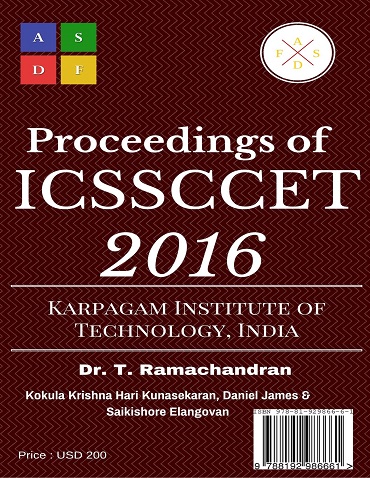- Publication Meta:Value
- Short Title:ICSSCCET 2016
- Publisher:ASDF, India
- ISBN 13:978-81-929866-6-1
- ISBN 10:81-929866-6-7
- Language:English
- Type:Hard Bound - Printed Book
- Copyrights:ICSSCCET Organizers / DCRC, London, UK
- Editor-in-Chief:Dr T Ramachandran
- Conference Dates:18 - 19, March 2016
- Venue Country:Coimbatore, India
- Submitted Papers:825
- Acceptance Rate:8.12%
- Website:www.icssccet.org
Welcome to ASDF Electronic Digital Library!
ICSSCCET 2016
ICSSCCET 2016
International Conference on Systems, Science, Control, Communication, Engineering and Technology 2016
Paper 158
Studies on Denim Fabrics for Their Market Size and Growth and Their Fabric Physical Properties
T Ramachandran1, G Nagarajan2
1Principal, Karpagam Institute of Technology, Coimbatore, India
2Assistant Professor, Aksum University, Axum, Ethiopia.
Abstract
Denim is a fabric manufactured out of 100% cotton fibers and the woven fabric construction is in general of twill weave construction. The wearers, especially the youth, in cities beyond the metros and mini metros are growing exceptionally inspirational that they are increasingly accepting denim as a core apparel category of fabric among the other varieties to be worn as an everyday casual garment. Traditionally, the denim fabric is blue denim constructed with a warp-faced twill in a 3 up 1 down construction. In general, coarse yarns spun from ring spinning system or in rotor spinning system are used for the denim fabric manufacture. The warp yarns are dyed with a solid colour like indigo dyes and the weft yarns are used without dyed. It means that there are more warp yarns than weft yarns appear on the face of the fabric and this gives a characteristic of the denim fabric a bluer face on the face of the fabric and moreover, much paler and almost white background on the back side of the fabric. The count of the yarns used for the manufacture of denim fabrics is in the range of Ne 10, Ne12, Ne 16 & Ne 20. Further more the warp and weft counts are different in character. i.e. Ne 12 warp yarn and Ne 10 weft yarn. In this study, few denim fabric samples were tested for their fabric properties like air permeability, fabric weight in gsm, EPI, PPI, count of warp & weft, crease recovery angles, water vapour permeability and thermal properties.
Keywords
Author's Profile
Author profile can be generated and linked through our partners World Book of Researchers. To include your profile online Click Here. After it is approved, please email to edlib @ asdf.res.in to create a link with all the papers.
e-AID
ICSSCCET.2016.158
Cite this Article as Follows
T Ramachandran, G Nagarajan. "Studies on Denim Fabrics for Their Market Size and Growth and Their Fabric Physical Properties" International Conference on Systems, Science, Control, Communication, Engineering and Technology (2016): 769-771. Print.
© 2010 - by EDLIB .
All Rights Reserved.

